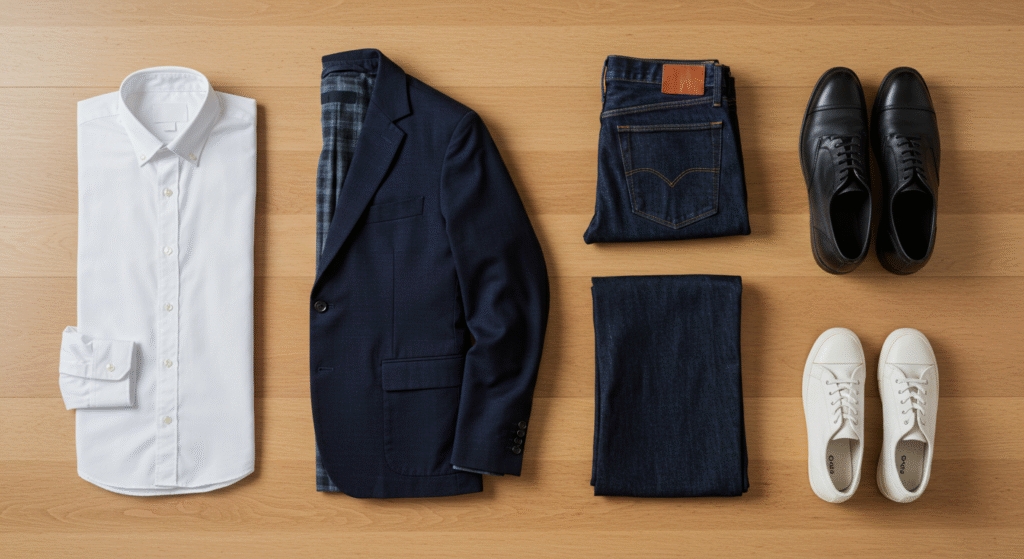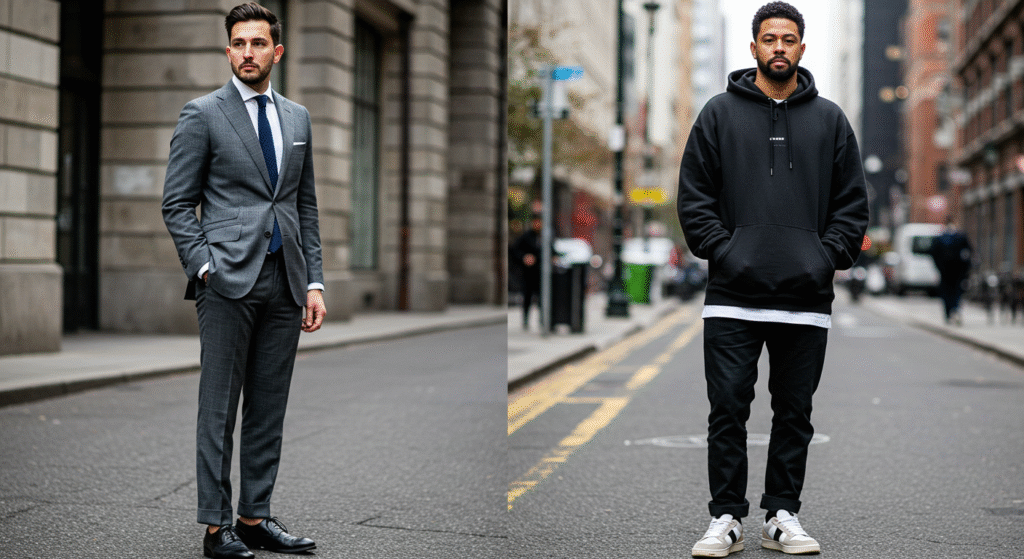The Modern Man’s Style Dilemma
Men today face an incredible range of style options. One moment, the streets are dominated by sneakers and oversized hoodies; the next, tailored suits and polished shoes are making a comeback. Navigating this world can feel overwhelming, but mastering different looks isn’t about chasing trends—it’s about understanding how to adapt, mix, and balance styles with confidence. The modern man doesn’t have to choose between streetwear and suiting; he can own both. This article explores how men can move seamlessly between casual and formal, blending influences to create a versatile wardrobe that always feels authentic.
Understanding the Spectrum of Style
Fashion for men can be seen as a spectrum, with streetwear on one end and formal suiting on the other. Streetwear embodies comfort, boldness, and cultural expression, while suiting represents tradition, elegance, and sophistication. The art lies in knowing when to lean into one side fully and when to blend the two. A man who understands this spectrum can walk confidently into a casual brunch, a creative office, or a black-tie gala without missing a beat.
The Roots of Streetwear and Suiting
Streetwear grew out of skate, hip-hop, and youth subcultures, becoming a global fashion movement defined by sneakers, hoodies, graphic tees, and relaxed silhouettes. It is expressive, playful, and often rebellious. Suiting, on the other hand, has centuries of history tied to refinement and social stature. The suit remains one of the most powerful symbols of masculinity and professionalism. Learning to master both requires respect for their origins while adapting them to modern life.
Building the Streetwear Side of the Wardrobe

Streetwear doesn’t mean sloppy—it can be clean, intentional, and stylish. The foundation includes high-quality T-shirts, slim or relaxed denim, hoodies, bomber jackets, and, of course, sneakers. A timeless streetwear outfit might combine dark jeans, white sneakers, and a simple hoodie layered under a bomber. Accessories like caps, backpacks, and sunglasses complete the look. The secret is balancing comfort with cohesion—choosing pieces that are simple yet impactful.
Elevating With Tailoring
On the opposite end, every man should own at least one well-tailored suit in navy or grey. This isn’t just about weddings or job interviews; a suit communicates respect and confidence. To master suiting, pay attention to fabric, fit, and accessories. Wool suits are versatile, breathable, and elegant. Shirts should be crisp and clean, shoes polished, and ties understated. Once you’ve mastered the classic suit, you can experiment with textures, double-breasted jackets, or subtle patterns like houndstooth and windowpane.
The Art of Blending: High-Low Dressing
The real power lies in mixing streetwear with tailoring to create hybrid looks. This is where creativity meets sophistication. Think of pairing a hoodie under a blazer, wearing tailored trousers with sneakers, or combining a crisp white shirt with a bomber jacket. The key to blending is balance: one formal piece anchored by one casual piece. Too much streetwear in a formal context looks careless, while too much suiting in a casual context feels stiff. Done right, high-low dressing projects confidence and modernity.
Mastering Fit Across Styles
Whether it’s oversized streetwear or slim suiting, fit remains king. For streetwear, oversized should still respect proportions—shoulders should align, and trousers should drape cleanly without dragging. For suiting, tailoring is non-negotiable. Jackets must hug the shoulders, shirts should skim the torso, and trousers should break gently at the shoes. Even when blending styles, fit determines whether the outfit looks intentional or sloppy.
Color and Fabric Choices
Streetwear often embraces bold graphics, bright hues, and unconventional textures. Suiting, by contrast, leans on neutrals, subtle patterns, and refined fabrics like wool and cashmere. Blending them requires a thoughtful approach: grounding bold streetwear pieces with muted suiting staples. A navy blazer paired with a plain hoodie in neutral tones works far better than clashing colors. Similarly, sneakers in simple white leather complement a grey suit better than neon trainers.
Dressing for the Occasion

Context is everything. Streetwear dominates casual weekends, creative workplaces, or nights out, while suiting shines in weddings, formal dinners, and corporate settings. High-low blends work best in semi-formal or business-casual environments where creativity is welcome. The man who masters this understands the dress code, respects the environment, and then adds his own personality.
The Role of Accessories
Accessories bridge the gap between streetwear and tailoring. A luxury watch works with both a hoodie and a three-piece suit. Sunglasses, leather belts, and minimalist backpacks can adapt across looks. Even sneakers—if clean and minimalist—can transition into smarter outfits. Avoid over-accessorizing; one or two well-chosen items elevate without overwhelming.
Grooming and Confidence
Clothes alone don’t complete the look. Grooming, posture, and confidence make the difference between wearing an outfit and being owned by it. Streetwear thrives on relaxed confidence, while suiting requires sharper presence. In both cases, neat grooming, clean shoes, and good posture are non-negotiable. Confidence ties everything together, making any style feel authentic.
Timeless Icons Who Mastered Both Worlds
Celebrities and style icons often embody the art of mixing worlds. David Beckham seamlessly transitions from tailored suiting to streetwear-inspired casuals. Pharrell Williams pioneered luxury streetwear long before it was mainstream. Ryan Gosling demonstrates how classic tailoring can be reinterpreted for modern settings. These figures prove that mastering different looks isn’t about choosing one lane—it’s about versatility.
How to Start Your Own Transformation
For men looking to expand their style range, the first step is auditing the wardrobe. Build strong foundations in both streetwear (dark denim, plain tees, clean sneakers) and suiting (navy blazer, grey trousers, black shoes). Then, experiment with blending—start small, like pairing sneakers with tailored trousers, before moving on to bolder mixes. Documenting looks through photos helps refine what works best. Over time, this experimentation evolves into personal style.

Conclusion: Owning the Full Spectrum
Mastering style today isn’t about staying in one category—it’s about owning the full spectrum. Streetwear provides freedom and expression, suiting delivers elegance and power, and blending the two creates modern sophistication. The modern man doesn’t have to choose; he can wear a hoodie with confidence on Saturday, a suit with authority on Monday, and a mix of both on Friday night. The key lies in respecting the rules of fit, quality, occasion, and balance. Once you understand these principles, you can move from streetwear to suiting effortlessly, commanding attention in any environment. Style, after all, is not about clothes—it’s about the man who wears them.







